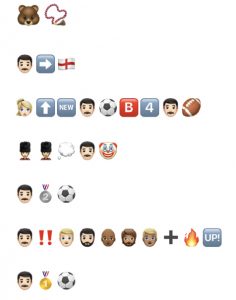The process of creating the emoji story was similar to creating the Twine task previously in the sense that it was very organic and unplanned. When starting the task, I did begin with the title. This is because I chose the particular work since I could visualize the emoticons for the title immediately in my head, partially due to familiarity from the use of the emoticons I selected. I also began with the title due to my primary interaction with texts being in traditional forms of media, such as books or journal articles, which always begin with the title at the top of the page. I even found myself trying to establish a manner of underlining the emoticons that constitute the title of my chosen work to match the formatting that I commonly use when producing texts.

An immediate challenge that I faced was that I had chosen my work based on my presumption that an emoticon existed to represent part of the title, however, I was mistaken. I had to then substitute another emoticon that was similar, however, I had hesitation because I was concerned that the meaning of the symbol could be misconstrued by the reader. The idea of depiction as discussed in Kress’ (2005) article, where he says that anything can be depicted at any rate with great specificity, which is a strength of depictions versus writing (pg. 15) was something that I connected to here. While emoticons serve as a sort of digital depiction, they are still limited in their communication potential by the fact that they are still a curated alphabet. With a company, such as Apple, creating this alphabet library, they are the ones selecting important words/ideas that are being represented, representing popular culture. There is no chance to add more details, like a drawn depiction, rather relying on a combination of symbols that individual people may interpret differently.
In order to create my emoji story, I relied primarily on ideas and ideas, while also utilizing a few syllables. With the majority of the emoticons available, they are mostly designed to represent specific words, which I made use of. It is interesting to note that while emoticons typically represent words, there are ones that take on different meanings in cultural significance. For example, the flame emoticon would refer to the word “fire”, but that was not the context I used it for, rather to refer to an emotion. This allows for a multiplicity of meaning for emoticons. I would be curious to see emoticon popularity between cultures to see if there are the same trends in popularity with the emoticons that have taken on alternate cultural meanings.
References
Kress (2005), Gains and losses: New forms of texts, knowledge, and learning. Computers and Composition, Vol. 2(1), 5-22.
In the end I wasn’t able to figure what your story was, although I’m pretty sure I know where it’s set, but the way it’s presented (simple, and easy to “read”) is great, and there’s some really interesting analysis. So what was it?!
Hi Nick,
I chose the AppleTV show “Ted Lasso” for this activity. It is about an American football coach who is hired to coach one of the Premier League’s teams despite knowing nothing about football (soccer). Highly recommended if you are not offended by swear words. Thanks for the reply!